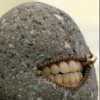The small polygynous ants may be a parasitic species like Solenopsis molesta. All I know about Manica is that they are rather hard to keep and are semi-claustral.
Possible, but don't think so. they're more stout and the queens look quite different. they are also almost pitch black with a dark rusty sheen. I have a colony of both and even without magnification you wouldn't mistake one for the other. Solenopsis Molesta queens are barely a 1/5 the size and Solenopsis Molesta workers about a 1/2 the size. I can't really say what they are, but at a guess they look more like Aphaenogaster.
They pretty much ignore people even when disturbed; if they run at all they just slowly saunter away. You can have them crawling all over you and you'd be hard pressed to get them to sting you. The sting is more like a twitch than actual pain. Nests have upwards of 5 to 8 queens easily. I've never seen them prey on anything other than Formica and Camponotus. In the latter case it's quite obvious, they carry away enclosed workers and larvae that are many times the size of their own queens. I've seen them live with Manica and Lasius and neither even reacts to the other at all.
More on topic, the Manica here make _) (_ shaped towers (3 to 5cm in diameter) on many of their nest entrances and conical domes on their other entrances. In the former case there are wide open holes in the top. In both cases they enter and exit from smaller holes in the bottom. Could that relate to part of the difficulty of keeping manica? Can anyone comment about the humidity that Manica like?
Looking around to see if other ants do it it seems Polyrhachis Macropa also make hyperboloid towers, but on a much larger scale.
Example of P. Macropa towers:
http://www.puu.sh/oua8o/02166b8012.png
For the Manica here it's such that if you see a tower and look under the closest stone, then there they are. I saw a few different pictures of the Manica version, but now I can't seem to find them. The major differences are the numerous holes at the base and much smaller size for Manica. The hyperboloid shape lends to stability; the many holes at the base make me think they're cooling towers or wind catches. It's just a guess but if it's not just arbitrary it'd mean they naturally want fairly wet substrate, but fairly dry air.
If anyone who's kept them can confirm or deny it'd be great.
Edit: Found a picture. This is what they look like when they are closed:
http://bugguide.net/node/view/409371
Edited by Meiun, April 24 2016 - 10:23 AM.


















